Would you like to experience yoga headstand – sirsasana – in an easeful, stress-free way? Through awesome alignment you can.
For the ‘king’ of yoga poses, this is where two props come in – the humble yoga brick and yoga block. Photos below. They facilitate the necessary physical and energetic alignment that make for a stable pose, in which the body seems to float effortlessly and the mind can be free.
This also supports our progression to practising the pose confidently in the middle of the room.
‘Regular and precise practice of sirsasana develops the body, disciplines the mind and widens the horizons of the spirit. One becomes balanced and self-reliant in pain and pleasure, loss and gain, shame and fame and defeat and victory’.
B.K.S. Iyengar, Light on Yoga
The health benefits of headstand are too good to refuse. According to B.K.S. Iyengar, going upside-down in this way rejuvenates the brain’s functioning through pure blood flow to the its cells. We enjoy an increase in acuity and clarity. Those suffering from sleep loss gain energy. The immune system is bolstered.
I would add that headstand brings courage and confidence and an invaluable change of perspective. Once we feel stable, it brings a sense of peace, that elusive sense of equanimity Iyengar alludes to.
I’d like to share two options for working with these props: one for the more flexible, the other for the less so.
Choose whichever option best suits your body. If you are new to headstand, do work with the supervision and guidance of a teacher.
Option 1 – for the more flexible
The challenge for the flexible in headstand is to find stability. Without this, we simply collapse in the pose – and wobble a lot.
This Stonehenge-like option helps us to ground and then ‘lift’ in the pose, rather than collapsing through the shoulder blades. When we collapse like this, the spine curves as if in a backbend, the lower ribs jut out, the shoulders drop, there is compression (and discomfort) in the neck and the whole energy of the pose is disturbed.
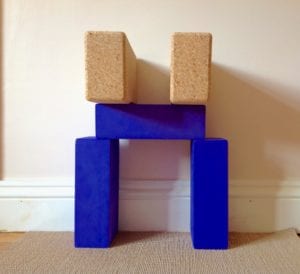
If you are not yet familiar with how to place the hands and forearms in the pose, please learn this with a teacher. The hands go between the two bottom bricks, as does the crown of the head. The two upper bricks support the space between the shoulder blades, so that there is no room for them to collapse inwards towards the spine. This support feels incredible!
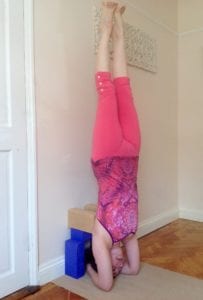
Keep rooting, pushing down into the ground through the wrists and forearms. Reach up high through the balls of the feet, engaging both the fronts and backs of the legs. Keep the face and mind soft and easeful. Breathe steadily through the nose, without controlling the breath.
I like to ‘walk’ into the pose, one leg up and then the other follows. You could, if you prefer, bend the knees into the chest and then gradually straighten the legs.
Exit slowly and gently on an exhalation and rest in child’s pose with the head on the mat for some moments. Then sit or stand up slowly.
Option 2 – for the less flexible
The challenge for the less flexible in headstand is often the curve of the spine (inwards, towards the chest) which makes it difficult to enter and remain comfortably and safely in the pose.
There are a couple of approaches here:
a) The stacking of blocks you see below is fantastic for creating length in the spine – easing out the curve.
Again, place the hands and crown of the head in between the bottom blocks.
Again, I find walking into the pose, one straight leg at a time, the easiest and most comfortable form of entry. For those with tighter hamstrings, bend the knees in to the chest with the hips above the shoulders, and gradually straighten the legs from there.
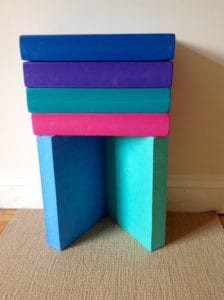
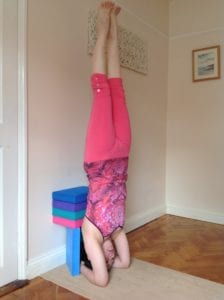
b) For those with a longer curve in the spine, extending to or beyond the middle of the back, the addition of a brick on top of the blocks is extremely effective. See below:
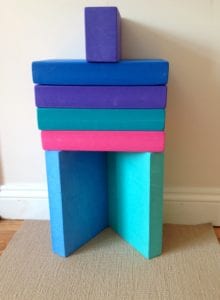
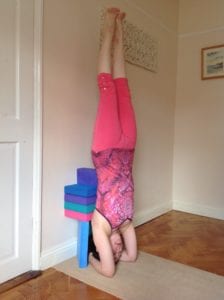
Whichever option you practise, be sure to root down through the forearms and wrists and reach up through the legs and feet. Keep the fingers soft and tension-free and the breath nice and steady.
After exiting, rest in child’s pose for some breaths before coming up slowly to sitting or standing.
If you are less experienced, work with a teacher.
Initially stay perhaps for one minute, if this is comfortable, and very gradually extend your time in the pose.
Over time, we develop the necessary strength, stability and technique in the pose.
What I also like about these modifications is that we are supported in the upper body, but the rest is away from the wall. This develops both strength and a sense of balance or weightlessness.
We can then progress to practising without the props, as the body has absorbed the alignment it has learned. It’s good to begin to do this in a corner between two walls, before venturing to practising in the middle of the room. There’s no rush.
If you would like one-to-one help with headstand (or other areas of your yoga practice), in north Herts, do contact me.
Photos: author’s own
You might also like:
Releasing fear through yoga